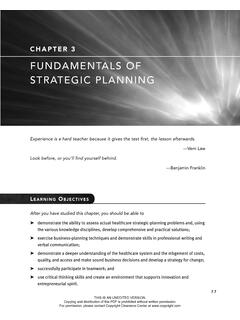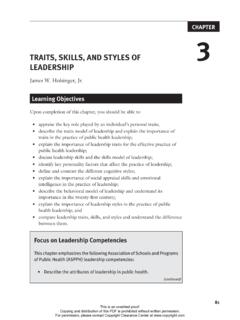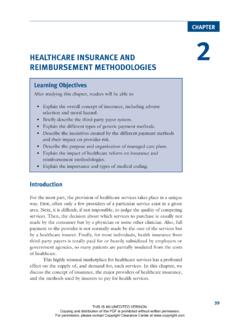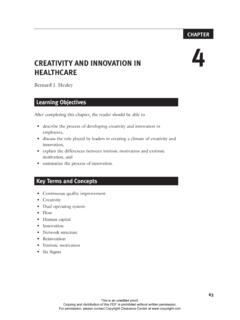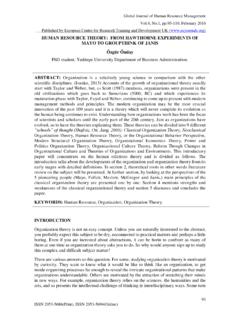Transcription of INTRODUCTION TO HEALTHCARE FINANCIAL MANAGEMENT
1 CHAPTER3 INTRODUCTION TO HEALTHCARE FINANCIAL MANAGEMENTL earning ObjectivesAfter studying this chapter, readers should be able to explain the difference between accounting and FINANCIAL MANAGEMENT ; discuss the role of FINANCIAL MANAGEMENT in health services organizations; explain how the goals of investor-owned and not-for-profit businesses differ; describe, in general terms, the tax laws that apply both to individuals and to HEALTHCARE businesses; and assess the implications of the major changes facing HEALTHCARE delivery for the FINANCIAL MANAGEMENT of HEALTHCARE study of HEALTHCARE FINANCIAL MANAGEMENT is fascinating and rewarding. It is fascinating because so many of the concepts involved have implications for both professional and personal behavior.
2 It is rewarding because the health-care environment today, and in the foreseeable future, is forcing managers to place increasing emphasis on FINANCIAL implications when making operating and foremost, FINANCIAL MANAGEMENT is a decision science. Whereas accounting provides decision-makers with a rational means by which to bud-get for and measure a business s FINANCIAL performance, FINANCIAL MANAGEMENT provides the theory, concepts, and tools necessary to make better decisions. Thus, the primary purpose of this textbook is to help HEALTHCARE managers and students become better decision-makers. The text is designed primarily for nonfinancial managers, although FINANCIAL specialists especially those 1 This is an unedited proof.
3 Copying and distribution of this PDF is prohibited without written permission. For permission, please contact Copyright Clearance Center at s Understanding HEALTHCARE FINANCIAL Management4with accounting rather than finance backgrounds or those moving into the health services sector from other industries will also find the text major difference between this text and corporate finance texts is that we focus on factors unique to the health services sector. For example, the provision of health services is dominated by not-for-profit or nonprofit organizations (private and governmental), which are inherently different from investor-owned Also, the majority of payments made to HEALTHCARE providers for services are not made by patients the consumers of the services but rather by some third-party payer ( , a commercial insur-ance company, a government program).
4 This text emphasizes ways in which the unique features of the health services sector affect FINANCIAL MANAGEMENT Understanding HEALTHCARE FINANCIAL MANAGEMENT contains some theory and a great number of FINANCIAL MANAGEMENT concepts, its primary emphasis is on how managers can apply the theory and concepts; thus, it does not contain the traditional end-of-chapter questions and prob-lems. (Note, however, that end-of-chapter problems in spreadsheet format are available as ancillary materials.) Rather, the text is designed to be used with the book Cases in HEALTHCARE Finance, sixth edition, which contains cases based on real-life decisions faced by practicing HEALTHCARE managers. The cases are designed to enable students to apply the skills learned in this text s chapters in a realistic context, where judgment is just as critical to good decision-making as numerical analysis.
5 Furthermore, the cases are not directed, which means that although students receive some guidance, they must formulate their own approach to the analyses, just as real-world decision-makers must text and the casebook are oriented toward the use of spreadsheets that can help managers make better decisions. This text has accompanying spreadsheet models that illustrate the key concepts presented in many of the chapters. The casebook has spreadsheet models that make the quantitative portion of the case analyses easier to do and more is impossible to create a text that includes everything that a manager needs to know about HEALTHCARE FINANCIAL MANAGEMENT . It would be foolish even to try because the field is so vast and is changing so rapidly that many of the details needed to become completely knowledgeable in the field can be learned only through contemporary experience.
6 Nevertheless, this text pro-vides the core competencies readers need to (1) judge the validity of analyses performed by others, usually FINANCIAL staff specialists or consultants; and (2) incorporate sound FINANCIAL MANAGEMENT theory and concepts in their own managerial and personal is an unedited proof. Copying and distribution of this PDF is prohibited without written permission. For permission, please contact Copyright Clearance Center at 1: INTRODUCTION to HEALTHCARE FINANCIAL Management5 How to Use This BookThe overriding goal in creating this text was to provide an easy-to-read, content-filled book on HEALTHCARE FINANCIAL MANAGEMENT . The text contains several features designed to assist in learning the , pay particular attention to the learning objectives listed at the beginning of each chapter.
7 These objectives give readers a feel for the most important topics in each chapter and set learning goals for that chapter. After each major section, except the INTRODUCTION , one or more self-test questions are listed. Answers to these questions are not provided. When you finish reading each major section, try to provide reasonable answers to these ques-tions. Your responses do not have to be perfect, but if you are not satisfied with your answer, reread that section before the book, italics and boldface are used to indicate special terms. Italics are used whenever a key term is introduced; thus, italics alert readers that a new or important concept is being presented. Boldface is used solely for emphasis; thus, the meaning of a boldface word or phrase has unusual significance to the point being discussed.
8 Boxes are used to highlight key for-mulae or equations. As indicated in the preface, the book has accompanying spreadsheet models that match and sometimes expand on selected calcu-lations in the text. The sections of the text that have accompanying models are indicated by a web icon (see the margin). In addition to in-chapter learning aids ( , sidebars, time lines, solu-tions), materials designed to help readers learn HEALTHCARE FINANCIAL manage-ment are included at the end of each chapter. First, many chapters contain an integrative application section that shows how a method covered in the chapter can be used to solve a practical problem. Second, a feature called Chapter Supplement can be found online at for many chapters; this includes materials that are important but not essen-tial to the concepts discussed.
9 Third, a summary section titled Chapter Key Concepts briefly reviews the most important topics covered in the chapter. If the meaning of a key concept is not apparent, you may want to review the applicable section. Fourth, a section called Chapter Models, Problems, and Minicases indicates whether spreadsheet models, problem sets, and minicases are available for that chapter. (See the preface for more information on these ancillaries.) Finally, each chapter includes a selected bibliography and list of selected websites. The books and articles listed in the bibliography can pro-vide a more in-depth understanding of the material covered in the chapter, while the list of websites is designed just to scratch the surface of relevant material available the web at: PinkSong8eThis is an unedited proof.
10 Copying and distribution of this PDF is prohibited without written permission. For permission, please contact Copyright Clearance Center at s Understanding HEALTHCARE FINANCIAL Management6 Taken together, the pedagogic structure of the book is designed to make the learning of HEALTHCARE FINANCIAL MANAGEMENT as easy and efficient as Briefly describe the key features of the text designed to enhance the learning QUESTIONThe Role of FINANCIAL MANAGEMENT in the Health Services SectorThe primary role of FINANCIAL MANAGEMENT is to plan for, acquire, and use funds (capital) to maximize the efficiency and value of the enterprise. Because of this role, FINANCIAL MANAGEMENT is known also as capital finance.


